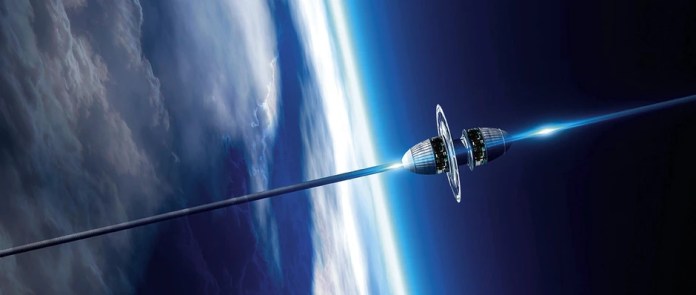What do you see when you look at the Moon? Beauty? Craters? Some people see dollar signs. You’ll occasionally see our only natural satellite billed as ‘Earth’s eighth continent’ because it’s full of resources that are hard to ignore. A rare form of helium, helium-3, could be used in fusion power stations here on Earth. Rare elements, such as neodymium, could be extracted and returned home for use in smartphones and other electronics.
But how do we get them here without blowing all the profits on rockets? According to a study published in 2019, a lunar elevator could be the answer. A cable anchored to the lunar surface would stretch most of the 400,000km (250,000 miles) home. It couldn’t be directly attached to the Earth, due to the relative motions of the two objects, but it could terminate high in Earth orbit.
That would have the added benefit of placing it above the bulk of our space junk, a growing problem as we launch ever more satellites. Solar-powered robotic shuttles could move up and down the cable, acting as a conveyor belt to ferry precious resources our way.
It may sound like an outlandish prospect, but Zephyr Penoyre and Emily Sandford – the two University of Columbia astronomy PhD candidates behind the study – believe we could pull it off for a few billion US dollars.
To put that into context, Jeff Bezos liquidates $1bn (over £700m) of his Amazon stock every year to fund his Blue Origin space tourism company. NASA’s Artemis programme, which is sending the first female astronaut and first astronaut of colour to the Moon later this decade, is costing $86bn (£60bn). Such is the value of the Moon’s resources, a separate study estimated that a lunar elevator would pay for itself within just 53 trips.
The cable, which would be no thicker than a pencil, would weigh 40 tonnes – well within the remit of modern rockets, such as SpaceX’s Starship. Unlike a space elevator that would travel from Earth’s surface into space, a lunar elevator stopping slightly shy of our planet wouldn’t have to contend with huge gravitational forces.
The Moon has no atmosphere either, which simplifies matters. That means the cable could be made from existing materials, such as Kevlar, instead of the yet-to-be-invented super-strong materials needed for an Earth-to-space elevator.
We could also combine the two. In April 2021, Chinese state-run media presented the country’s idea for a ‘Sky Ladder’. This would see a spacecraft winched up an elevator from Earth’s surface to a waiting space station, before being flung towards the Moon where it would meet another elevator that would lower it down to the lunar surface.
The idea of space elevators has been around for over a century without much progress. But if enough people – or, more likely, corporations – become enamoured with the chance of making big bucks, we could see the lunar equivalent of a gold rush in the decades ahead. Elevators could well turn out to be a way to keep costs down and profits literally sky-high.
